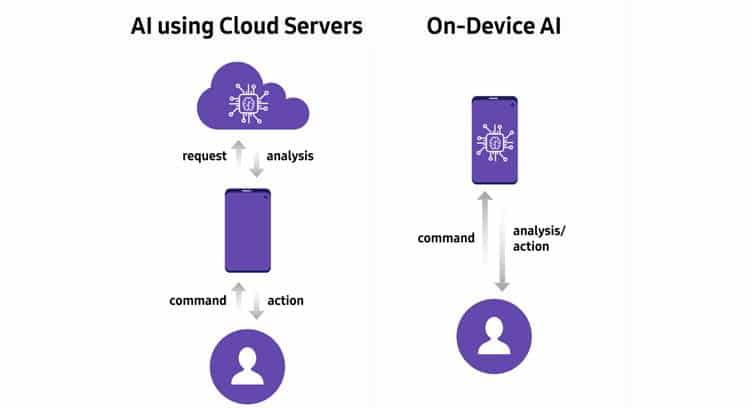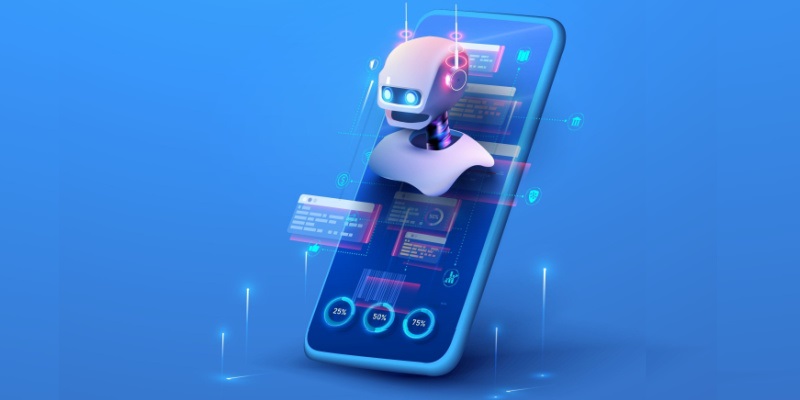The Dawn of the On-Device AI Revolution
The smartphone in your pocket has undergone a silent, yet monumental, transformation. Once a mere portal to the internet and a tool for communication, it has evolved into a formidable artificial intelligence engine. This evolution marks a critical shift in the landscape of technology, moving complex computational tasks from distant cloud servers directly into the palm of your hand. We are witnessing the maturation of on-device, or “edge,” AI, where the processing happens locally, delivering unprecedented speed, privacy, and capability. The latest AI Phone & Mobile Devices News isn’t just about faster processors or better screens; it’s about the burgeoning intelligence within these devices. This intelligence is now so powerful that it’s being used in research projects to tackle challenges once thought to be the exclusive domain of dedicated supercomputers, including the complex, real-time decision-making required for autonomous vehicles. This article explores the hardware, software, and real-world implications of this on-device AI revolution, examining how the supercomputer in your pocket is shaping the future of everything from personal robotics to smart cities.
From Cloud Dependence to On-Device Intelligence
In the early days of mobile AI, features like voice assistants and photo tagging were largely cloud-based illusions. When you spoke to your phone’s assistant, your voice was recorded, compressed, sent to a massive data center hundreds of miles away, processed by powerful servers, and the response was sent back. This model, while effective, was saddled with inherent limitations: latency, a constant need for an internet connection, and significant privacy concerns, as your personal data was continuously traversing the internet. The latest trends in AI Edge Devices News highlight the industry’s concerted effort to sever this digital tether.
The Compelling Case for Edge AI
The move to on-device processing is driven by a convergence of user demands and technological feasibility. The benefits are transformative, fundamentally changing how we interact with our devices and the services they provide. These advantages include:
- Unmatched Speed and Responsiveness: By eliminating the round-trip to the cloud, on-device AI can perform tasks in real-time. This is critical for applications like live language translation through a camera, seamless augmented reality (AR) overlays, and the instantaneous analysis seen in the latest AI-enabled Cameras & Vision News.
- Fortified Privacy and Security: On-device processing means sensitive information—such as biometric data for face unlock, personal health metrics, or the content of your private messages—never has to leave your device. This user-centric approach to privacy is becoming a major selling point for modern gadgets.
- Unwavering Reliability: An AI feature that only works with a strong internet connection is a fragile one. Edge AI ensures that core intelligent functions, from camera enhancements to predictive text, work flawlessly on an airplane, in a subway, or in remote areas with poor connectivity.
- Greater Efficiency: Processing data locally reduces the need to constantly upload and download large amounts of information, saving battery life and cutting down on mobile data consumption. This efficiency is a key focus of ongoing AI Research / Prototypes News, aiming to make AI more sustainable.
This paradigm shift was not accidental; it was enabled by a revolution in mobile hardware, specifically the development of specialized processors designed from the ground up to handle the unique workloads of artificial intelligence.
Under the Hood: The Specialized Hardware Driving Mobile AI
The heart of any modern smart device is its System on a Chip (SoC), an integrated circuit that houses the CPU, GPU, and other critical components. For years, performance gains were measured by CPU clock speeds and GPU core counts. Today, the most important metric in mobile performance is AI processing power, driven by a specialized component: the Neural Processing Unit (NPU).

The Rise of the NPU and the Race for TOPS
An NPU, sometimes called an AI accelerator or Neural Engine, is a microprocessor specifically designed to accelerate the mathematical operations at the core of neural networks, such as matrix multiplications and vector calculations. While a CPU is a generalist and a GPU excels at parallel tasks for graphics, an NPU is a specialist, performing these specific AI tasks with vastly greater speed and power efficiency. The performance of these NPUs is often measured in TOPS (Trillions of Operations Per Second).
A few years ago, a mobile NPU capable of 1-2 TOPS was considered state-of-the-art. Today, flagship SoCs from industry leaders like Apple (A-series Bionic with Neural Engine), Google (Tensor SoC with Edge TPU), and Qualcomm (Snapdragon with AI Engine) regularly boast NPUs capable of 20, 30, or even more TOPS. This exponential growth in on-device computational power is the primary catalyst for the AI revolution we are experiencing. This hardware is also becoming the brain for a new generation of smart devices, a key topic in AI Sensors & IoT News, where on-device processing allows for smarter, more autonomous sensors that can make decisions locally without constant cloud communication. The future of this technology may even lead to direct Neural Interfaces News, where brain-computer interfaces are powered by similar, highly efficient chips.
From Your Pocket to the Pavement: Mobile AI in Action
The theoretical power of 30 TOPS is abstract, but its real-world applications are tangible and increasingly integrated into our daily lives and the wider technological ecosystem. The advanced AI capabilities of a modern smartphone are no longer confined to the device itself; they are serving as the blueprint and often the direct processing engine for a vast array of connected gadgets.
Case Study: A Smartphone Brain for an Autonomous Car
Perhaps the most striking demonstration of modern mobile AI prowess is its application in autonomous systems. Recent proof-of-concept projects have shown that a single, off-the-shelf smartphone can serve as the central processing unit for a self-driving vehicle. In these demonstrations, the phone’s NPU processes multiple real-time video streams from cameras mounted on the car. It performs a cascade of complex tasks simultaneously:
- Object Recognition: Identifying and classifying pedestrians, cyclists, other vehicles, and traffic signs.
- Lane Detection: Recognizing lane markings to keep the vehicle centered.
- Path Planning: Making rudimentary decisions about steering and speed based on the visual data.
While these are not production-ready systems for public roads, they are powerful proof points. The fact that a consumer device possesses the raw AI horsepower to handle a task as computationally demanding as autonomous navigation is a watershed moment. It validates the immense progress in mobile hardware and software optimization and is a major headline in Autonomous Vehicles News.
An Expanding Ecosystem of Mobile Intelligence
The same powerful and efficient SoCs pioneered in smartphones are now being adapted to power a diverse ecosystem of intelligent devices, creating a ripple effect of innovation:

- Wearables and Health Tech: The latest in Wearables News and Health & BioAI Gadgets News shows smartwatches and fitness trackers using on-device AI to perform advanced health monitoring, such as real-time ECG analysis, fall detection, and sophisticated sleep stage tracking, all while preserving user privacy.
- Robotics and Drones: As seen in Robotics News and Drones & AI News, consumer drones and home robots use on-board vision processing—powered by mobile-derived chips—for intelligent subject tracking, obstacle avoidance, and mapping environments without relying on a cloud connection. This is also expanding into AI Personal Robots for companionship and assistance.
- Augmented and Virtual Reality: The future of immersive computing, covered in AR/VR AI Gadgets News and Smart Glasses News, depends on on-device AI for Simultaneous Localization and Mapping (SLAM), hand tracking, and object recognition to seamlessly blend the digital and physical worlds.
- Smart Home and Security: The latest Smart Home AI News focuses on devices like smart displays and security cameras that use local processing. AI Security Gadgets News reports on cameras that can distinguish between people, pets, and packages on the device itself, sending specific alerts without uploading sensitive video footage to the cloud.
This trend extends across countless other categories, including AI Companion Devices News, AI Pet Tech News, and even AI Kitchen Gadgets News, all leveraging the power and efficiency of mobile AI hardware.
Navigating the Future: Challenges and Best Practices
Despite the incredible progress, the path to ubiquitous, powerful on-device AI is not without its obstacles. Developers and manufacturers must navigate a complex set of trade-offs to deliver intelligent, reliable, and ethical products. The latest AI Office Devices News and AI Education Gadgets News are also grappling with these same challenges as they seek to integrate more intelligence into their products.
The Triple Constraint: Power, Performance, and Privacy
The development of on-device AI is a constant balancing act between three critical factors:

- Power Consumption: Running complex neural networks is energy-intensive. A key challenge is optimizing AI models and hardware to perform amazing feats without draining the battery in minutes. This is a central theme in discussions around AI Sleep / Wellness Gadgets News, where long battery life is essential.
- Thermal Management: High-performance NPUs generate significant heat. Without sophisticated thermal design, a device can overheat and throttle its performance, negating the benefits of its powerful chip.
- Model Optimization: There is a direct trade-off between the size of an AI model (and thus its accuracy) and its computational cost. Developers must use techniques like quantization (reducing the precision of the model’s numbers) and pruning (removing unnecessary connections) to create models that are both powerful and small enough to run efficiently on mobile hardware.
Best Practices for a Smarter, Safer Future
As this technology becomes more pervasive, a responsible approach is crucial for both creators and consumers.
For Developers and Creators: The focus should be on efficiency and transparency. Leveraging dedicated development kits and APIs like Apple’s Core ML and Google’s TensorFlow Lite is essential for tapping into the full potential of NPUs. The growing ecosystem of AI Tools for Creators News is providing powerful resources to optimize models for the edge. Furthermore, developers must be transparent with users about what data is being processed on-device versus in the cloud and for what purpose. This is especially important for emerging categories like AI for Accessibility Devices News, where user trust is paramount.
For Consumers: It’s important to become educated about the technology in your devices. Pay attention to which brands and apps champion on-device processing as a privacy feature. Manage your app permissions carefully and be mindful of the data you share. By supporting products that prioritize local AI, consumers can help drive the industry toward a more private and secure future.
Conclusion: The Ubiquitous Intelligence of Tomorrow
The journey of mobile AI from a cloud-tethered novelty to a powerful on-device engine is one of the most significant technological stories of our time. The smartphone has become the testbed and incubator for a new class of AI-powered hardware that is now proliferating across every imaginable category of consumer electronics. The fact that a device we carry daily has enough computational power to pilot a vehicle—even in a controlled setting—is a clear signal that we have crossed a critical threshold. The future will not be defined by a single, all-knowing AI in the cloud, but by a distributed, decentralized network of billions of intelligent edge devices, working together to make our world more responsive, helpful, and secure. The latest AI Phone & Mobile Devices News is no longer just about phones; it’s about the blueprint for the ubiquitous intelligence of tomorrow.










